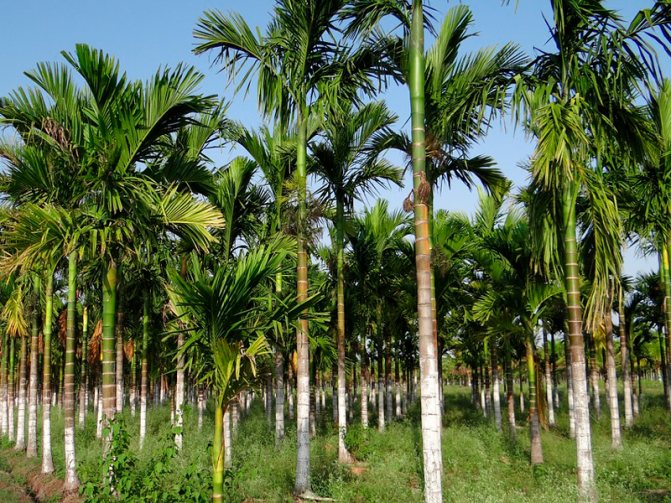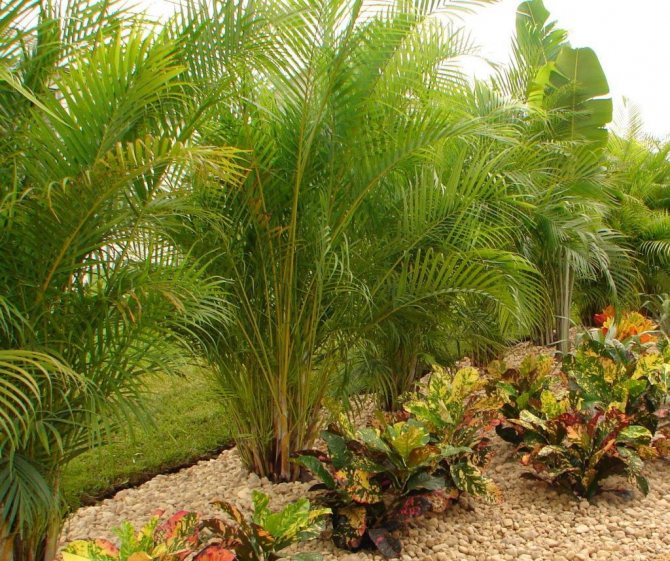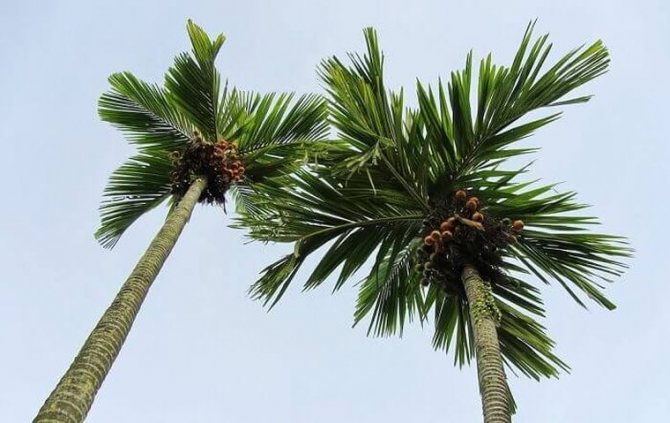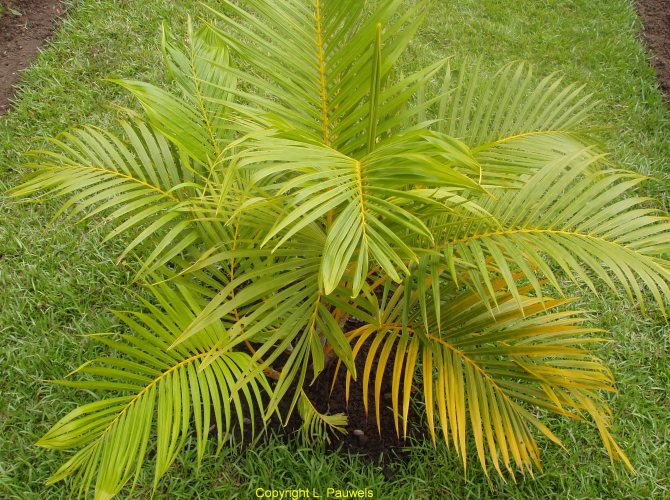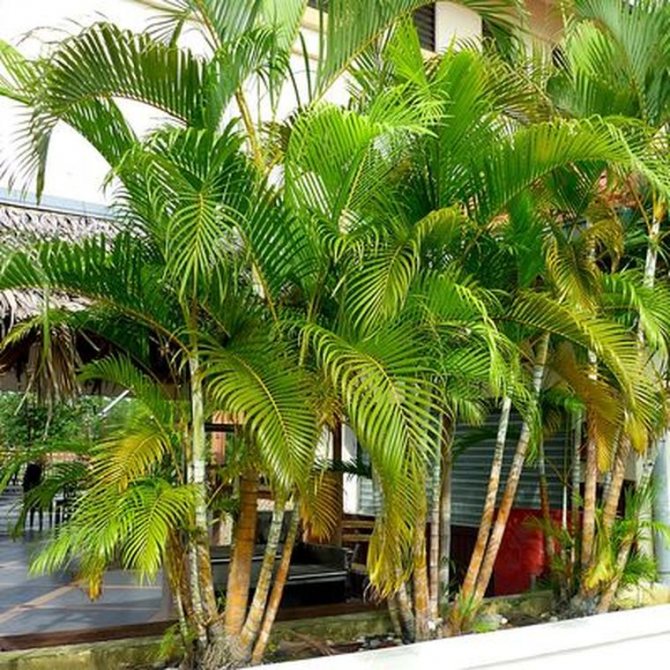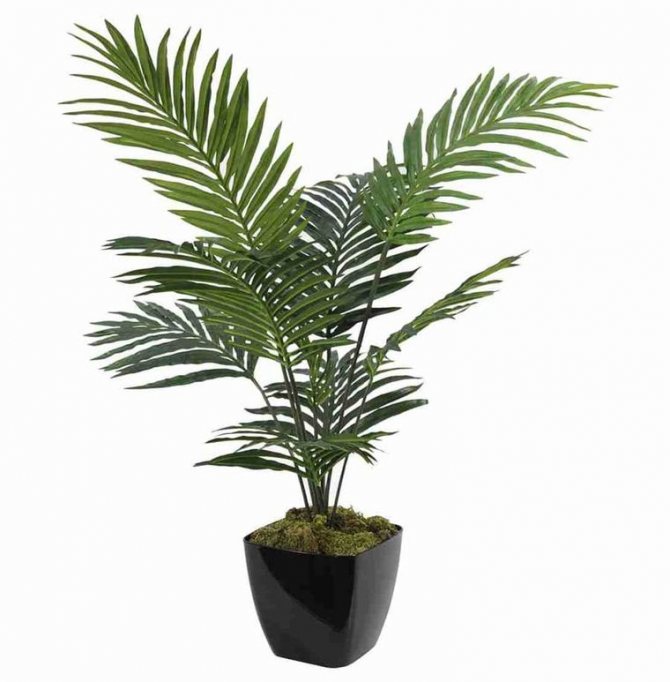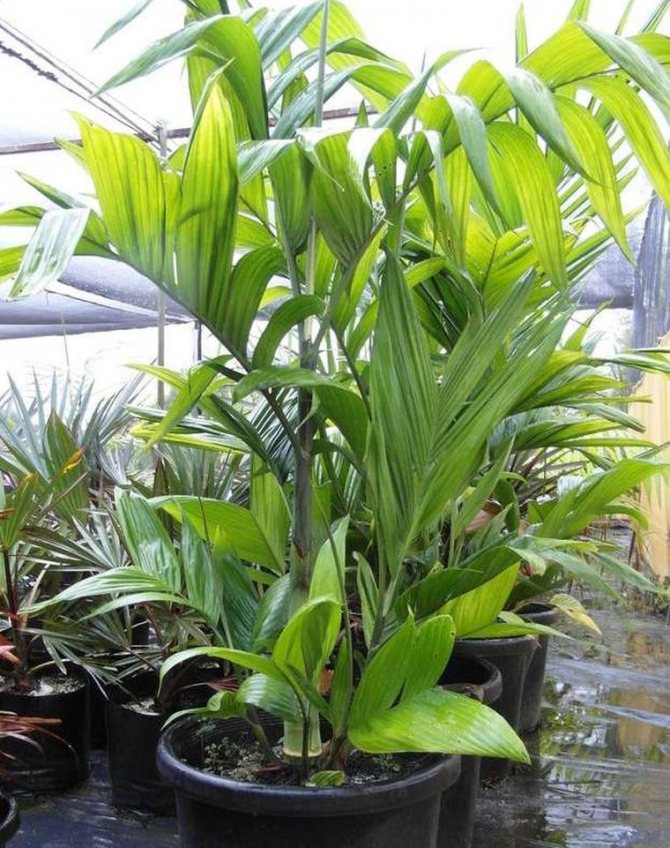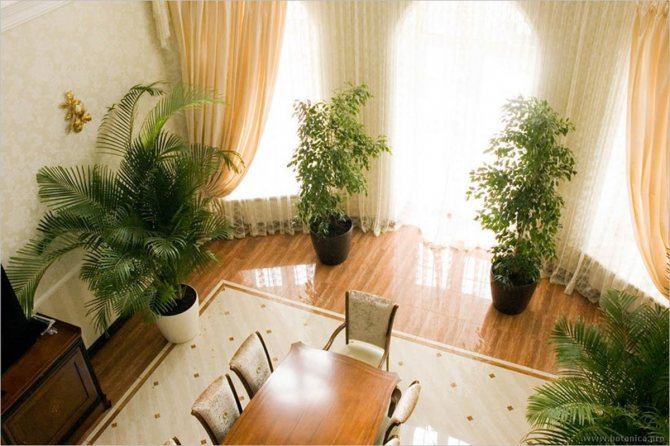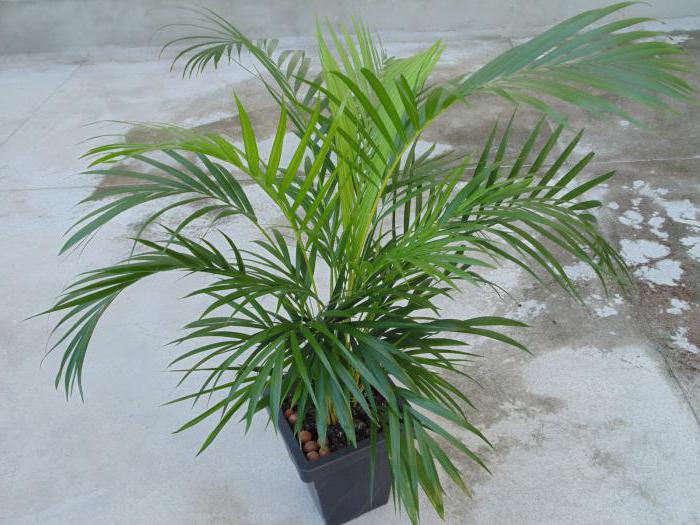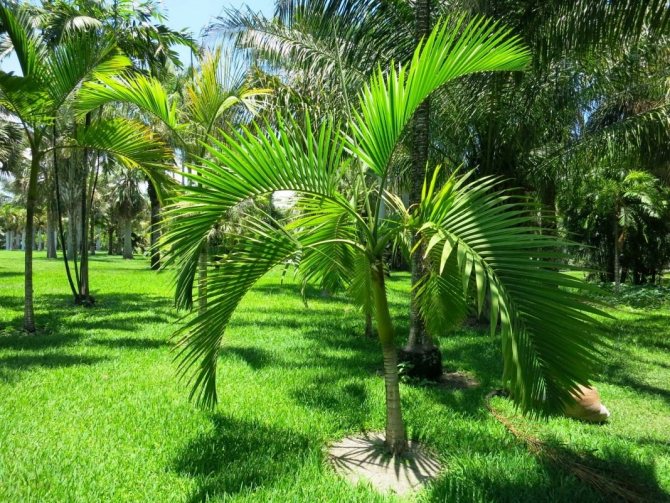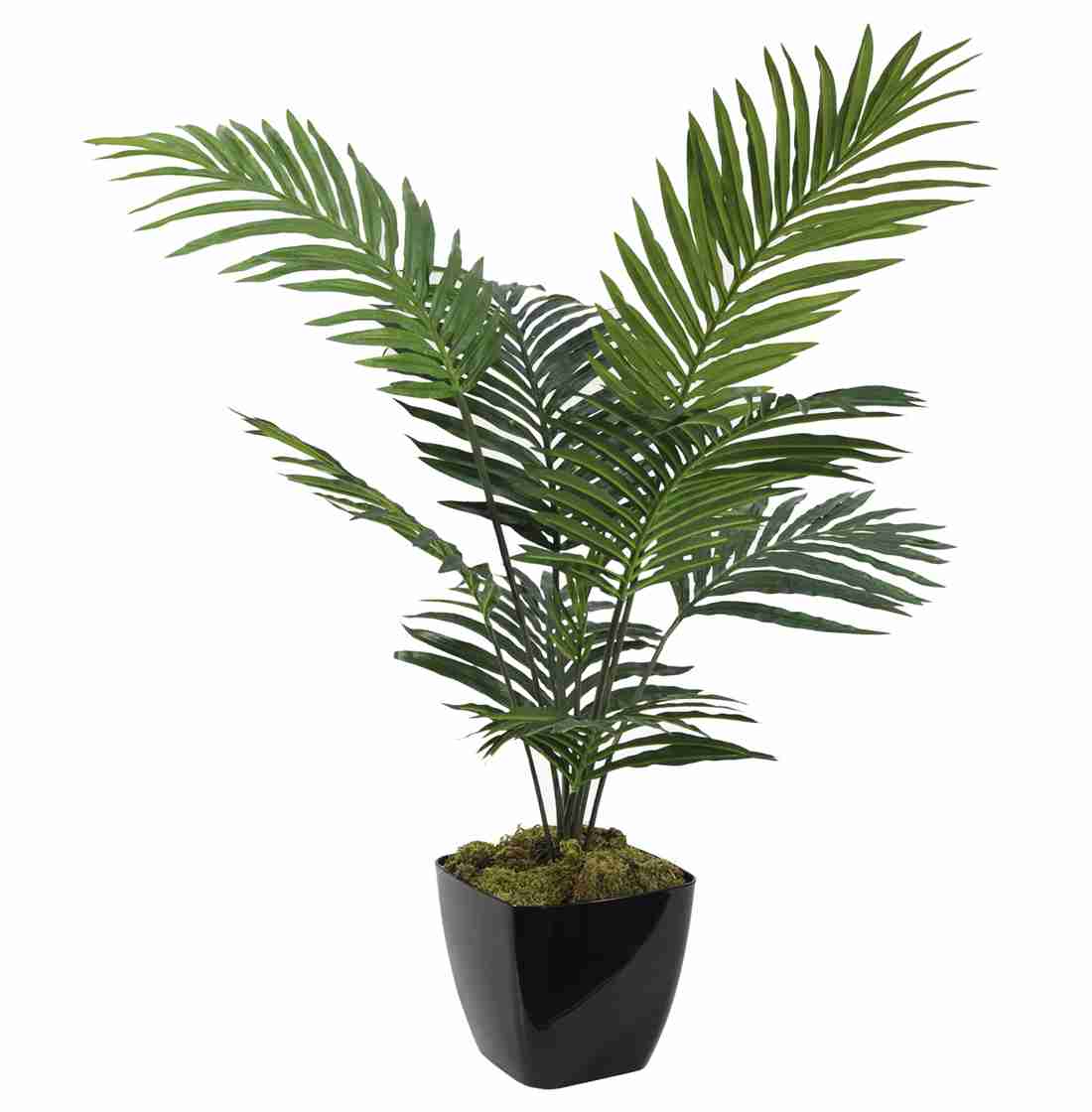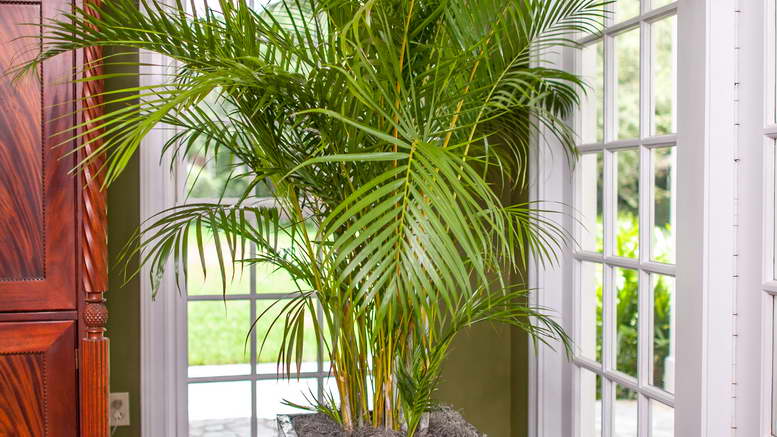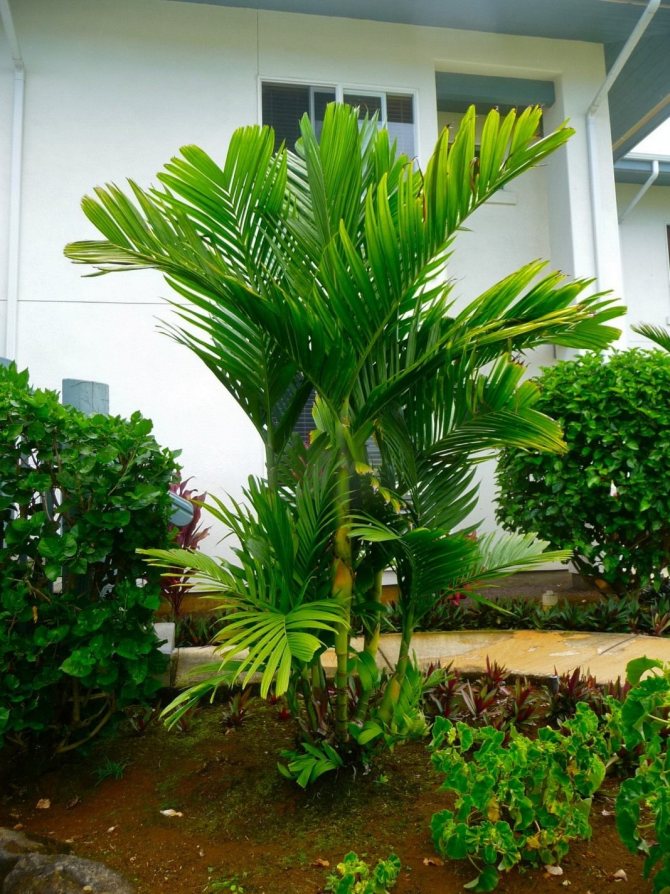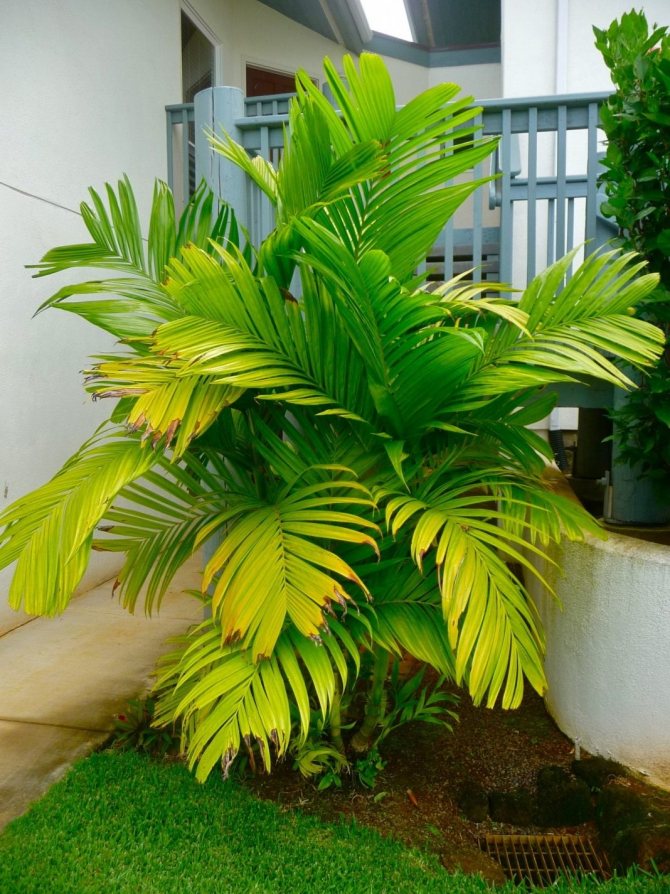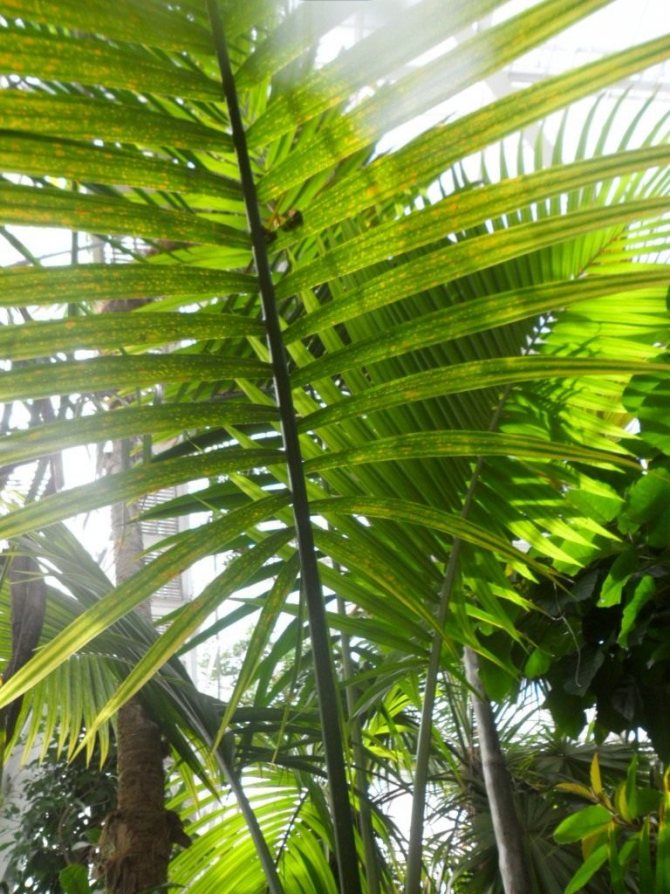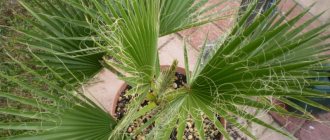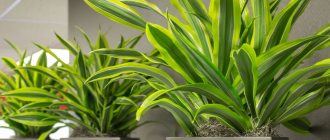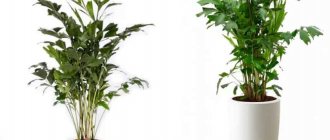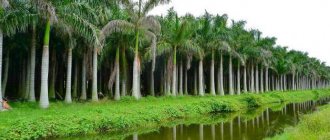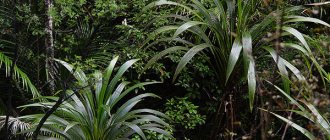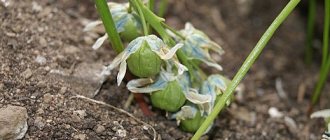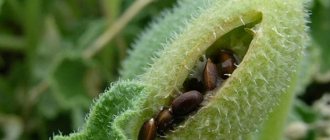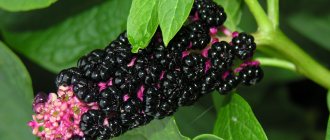Category: Care Published 03/24/2019 · Comments: · Read: 7 min · Views: 455
Few florists can resist the charm of this stately exotic beauty with lush fan foliage. In the tropics, she gained fame as a valuable economic culture, betel palms, they are also arecs, are specially grown and used in various industrial sectors. And thanks to its slow growth, the palm tree is an excellent house plant - spectacular, small-sized, not very whimsical. In addition, even a small indoor betel tree can be beneficial for both the home and its owner.
Illumination requirements
One of the main conditions for successfully growing areca palm at home is diffused lighting. Moreover, the plant should in no case be put in the shade. Areca palm loves only diffused sunlight, although direct sunlight is allowed on the foliage, it is still preferable to grow the flower in diffused lighting. Areca can put up with even a slight partial shade. In summer, be sure to shade the flower from the scorching sun.
If the palm tree suffers from an excess of sunlight, then its leaves will begin to curl, and the plant will lose its decorative effect. The sun can cause burns on the delicate leaves. The plant can even die if exposed to the sun on a hot summer day.
In order for the crown of the palm tree to develop correctly, every two weeks the pot is turned towards the light.
Betel palms in nature
The homeland of the areca is southern and southeastern Asia, but its area of growth is much wider today. It can be found in the flora of Oceania and East Africa.
In their natural environment, the height of these trees can reach 20 meters, but, like more compact indoor specimens, they have only one upright trunk, covered with annular scars - traces of fallen leaves. The trunk diameter of a wild palm is often 30-35 cm, and the length of the leaves is 1.5-2 meters.
The tree blooms with flowers of white-cream shades, giving after oval drupe fruits of red or orange color. Inside it is a betel nut.
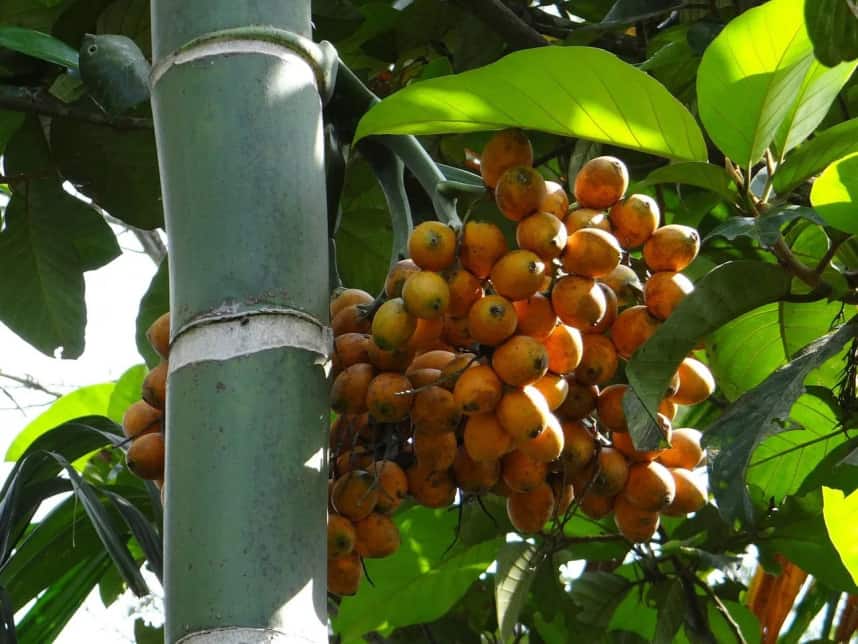
Soil and fertilizers
The indoor flower areca is quite picky about the composition of the soil. Loves acidic or neutral soil. The soil must be loose and permeable so that water quickly leaves it. The soil is considered ideal, which water, flowing down, soaks it well. Soil, through which water instantly passes and flows into the sump, is considered unusable.
It is imperative to lay a drainage layer in the pot, pebbles, perlite, sand, pumice and coarse peat are excellent as drainage.
The soil for growing this plant can be compiled on your own, such a mixture is perfect for areca - part of crushed pine bark, part of pumice, 2 parts of peat, part of pebbles, part of perlite, part of charcoal, some bone meal.
They begin to feed the palm tree in April and continue feeding until the end of August. You can use any complex fertilizer for indoor flowers. Fertilizers are applied once every two weeks. During the period of active growth, mineral fertilizing should be applied under the palm tree.
Conditions of maintenance and care of the betel tree
All palms are exotic plants from the tropics and subtropics, they are accustomed to conditions far from the indoor microclimate. However, practice has shown that they successfully adapt and if the owner pays attention to the main aspects of their maintenance, then the betel tree growing indoors will feel comfortable.
Suitable lighting and location for areca
Arecs are very photophilous and firmly tolerate direct sun, however, it is advisable to protect the plant from intense midday rays. A tub with a palm tree can be installed near the southern windows, it is enough to shade it a little. But, it will also grow in a semi-shaded place.
The tree is gradually taught to the bright sun so that burns do not appear on its foliage.
It is also recommended to turn the pot with a palm tree over so that the crown forms symmetrically. It is important to keep it away from drafts, their plant is very difficult to tolerate.
Temperature regime
Bethel is a visitor from warm countries, so it thrives at moderately high temperatures. The optimal summer temperature is + 24 - +26 degrees, in winter it can withstand a decrease to +16 degrees.
It should be borne in mind that when the temperature falls below + 16 degrees, arecs stop growing and get sick. And if the air temperature rises significantly against the background of a decrease in humidity, then the palm tree may die.
Many palm trees prefer to hibernate in the cool, however, betel palms do not need winter rest, so they grow well in warmth.
Air humidity
If we evaluate the "native" climate of betel palms, then high humidity is more suitable for them, regardless of the season. It is recommended to regularly spray the crown of the tree, irrigating the foliage on both sides.
Water should be soft, settled, ideally, melt or rainwater is taken, in extreme cases - tap water. It is useful to wipe the leaf blades with a damp sponge or cloth and place small specimens under a warm shower, having previously covered the soil with polyethylene.
During the heat or the operation of heating devices, you can place containers with water in the room or use air humidifiers.
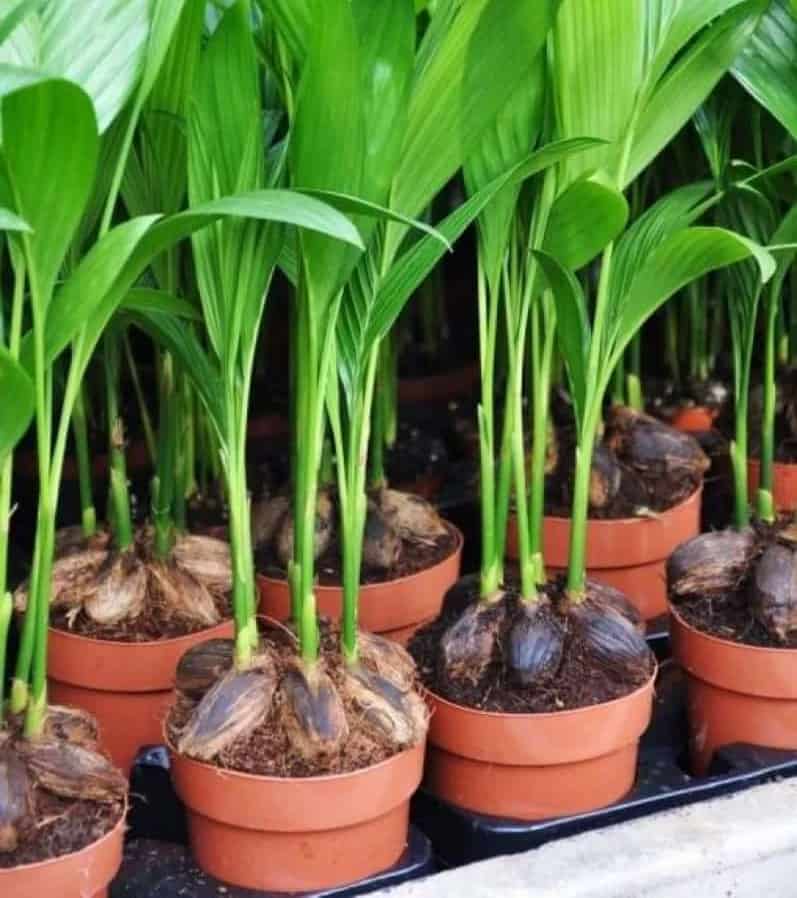

Watering rules
In the spring and summer there is a period of active growth of the plant, so it should be watered more abundantly and often. The water must first be defended and if they are too hard, then you can soften it by adding a little peat.
Moisture is added after the topsoil dries out to a depth of 3-4 cm. When the air temperature drops, the frequency of watering is halved.
Experienced palm owners often use the bottom watering method by placing the tree pot in a container of water. But it is effective only if the air in the room is stably warm.
Fertilizers and feeding
Betel palms can be fed with complex fertilizers containing mineral and organic substances. During the active growth of the tree, one procedure every 2 weeks is enough; in winter, the amount of dressings is reduced to 1 time per month or they are completely canceled. Organic matter is applied separately in May-June.
If the palm is transplanted into a properly selected soil mixture, then within six months it does well without additional fertilizers.
Soil quality and replanting
At the base of the trunk of a young areca, you can see the fruit from which it grew. In no case should you remove its parts, as this will lead to the death of the plant. They are removed only when they turn brown and separate.
Buying in a "family" arecs growing in the same container, the florist should know that when they are separated and transplanted, there are high risks of damage to the roots. In this case, all specimens die.
A young palm is transplanted once a year, an adult no more than once every 3-4 years.It is enough for large arecs to renew the topsoil annually without disturbing the rhizome.
In any case, it is recommended to use the “transshipment” method, in which the palm tree “moves” to a new pot with an old earthen clod:
- The bottom of the pot is filled with drainage.
- A 1-2 cm layer of soil mixture is placed on top.
- The plant is removed from the container and placed in a new container, the soil is not removed from the roots.
- The remaining voids are covered with earth up to the root collar. The palm tree is suitable for neutral or slightly acidic soil, nutritious, with a light consistency. You can prepare it yourself by adding 2 parts of leafy earth, 1 part of humus and the same amount of coarse sand to 4 parts of turf. To make it looser and acidic, you can add 1 part black peat, some charcoal and small pebbles.


Power shortage problems
Due to a lack of nutrients, the indoor palm tree can get sick. Typically, the following problems arise:
- Nitrogen. With a lack of nitrogen, the foliage becomes very light and the palm stops growing.
- Potassium. Due to potassium deficiency, yellowish spots appear on the leaves. After some time, the leaf dies.
- Magnesium. With a deficiency of this substance, yellow stripes appear on adult leaves.
- Manganese. Most often, due to manganese deficiency, young leaves suffer. Leaves develop poorly, chlorosis appears on them.
- Zinc. Due to the lack of zinc, small specks appear on the foliage.
Indoor varieties of betel palms
Biologists have managed to discover and classify nearly fifty species of these trees. However, only three of them can be grown indoors:
- Areca three-stalked (triandra)
It grows up to 3 meters in height, has long, up to 1.5 m and wide leaves, without bends. It is possible to divide the trunk from the base into 2-3 separate stems.


- Areca catechu
It is taller than most ornamental palms, so it is usually used to decorate spacious rooms with high ceilings. In street areks, the diameter of the trunk can reach half a meter, and the length of the foliage is 2 meters.
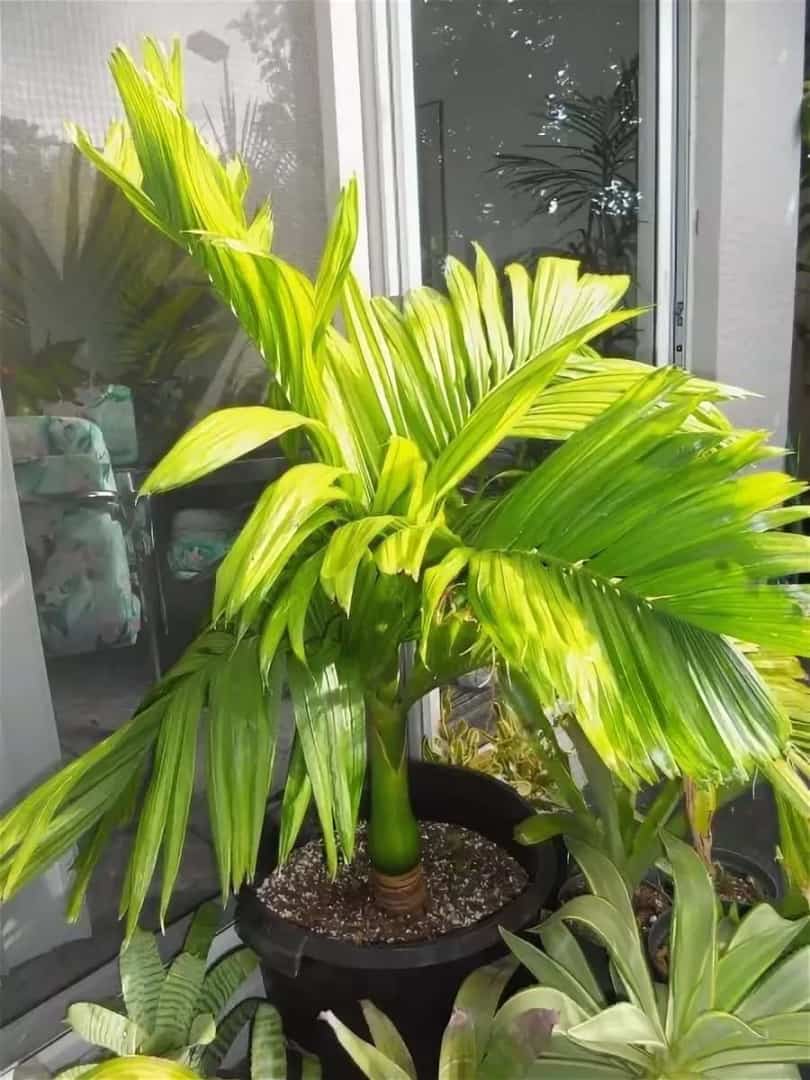

- Areca yellowing (lutescens)
The maximum growth of street specimens is 10 meters. The leaf blades are arched and relatively short - no longer than 30 cm.The trunk is thick, up to a meter in diameter.
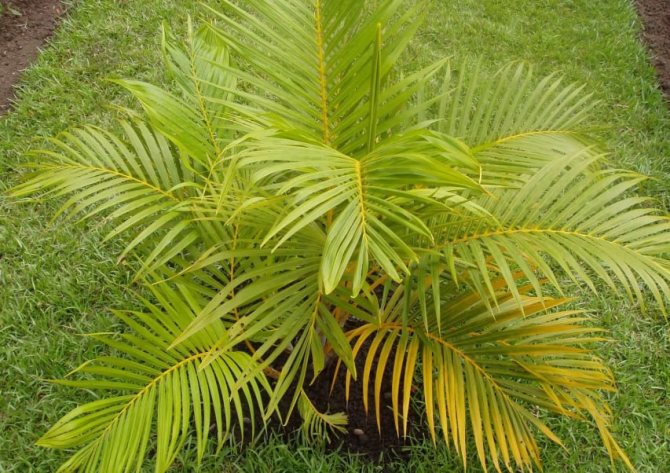

All betel palms are impressive in size and although indoor specimens are not so impressive, they all take up quite a lot of space. This is important to consider when purchasing an exotic pet.
Transfer
It is imperative to monitor the roots of the palm tree, since the plant cannot get out of the pot. Young specimens should be transplanted annually in the spring into larger flowerpots. Every year, a pot is taken a little larger in diameter than the old one.
It is very simple to transplant a palm tree - the plant, together with an earthen clod around the roots, is rolled into a new container. You can not bury the flower in the ground more than it grew before.
Mature palms no longer need such frequent replanting. Adult plants are transplanted every three to four years, when the roots completely occupy the volume of the pot. Too tightly intertwined roots are cut off when transplanting.
Self-breeding method of home areca
There is only one way to grow such a palm tree by sowing seeds. However, it is not easy to achieve a positive result, since planting requires constant heating of the substrate and high air humidity. If difficulties do not frighten, then you can use step-by-step instructions:
- A special substrate is being prepared from peat and sand.
- It is pre-moistened.
- The seeds are planted.
- The container is covered with polyethylene or glass to create a greenhouse effect.
The temperature of the soil mixture should be kept at the level of +25 - +27 degrees.The container should be ventilated every day, and the soil should be sprayed from a spray bottle with a fine mesh nozzle.
Even under ideal conditions, the first shoots will hatch no earlier than 12-16 weeks. Planting palm trees is best done in late spring or summer.
Possible problems
Most often, the palm tree is affected by fungal diseases, the main reason for the appearance of which is excessive watering.
Typically, fungal problems appear in the form of reddish or black streaks and spots on the sheets. Usually the halo of the speck turns yellow. If the conditions for the development of the fungus are favorable, then the disease will very quickly affect all the leaves.
Prevention is the best treatment for fungus. Palms should not be sprayed, the plant should be well lit and should not suffer from excessive dampness.
The plant can be attacked by spider mites, thrips, whiteflies and mealybugs. If pests are found, the palm tree should be treated with special preparations according to the instructions.
Description of culture
Among the 50 species of areca that exist in nature, there are miniature bushes up to 35 cm in height, and real giants are trees reaching 20 meters in height.
By plant classification areca is a tree with one or more tubular stems... The stems end with lush foliage, forming a kind of comb. The leaf plates are painted in rich shades of green. Originally dissected, they look like feathers.
In nature, the palm tree blooms, shooting out cob-shaped inflorescences, where small white flowers of the male and female genders are collected. After flowering, red-orange fruits with horn-shaped seeds are formed on the areca.
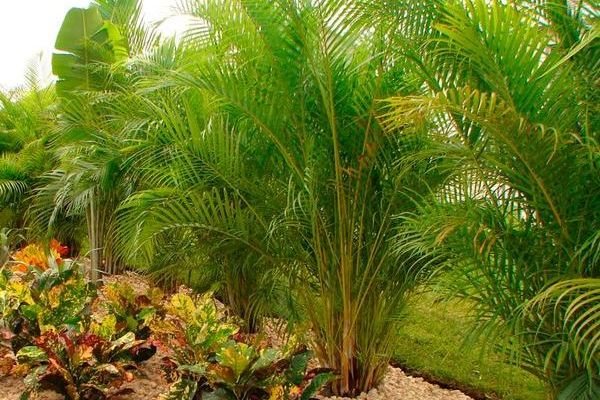

The external similarity of some of the Areca type palms confuses beginners who find it difficult to distinguish a true chrysalidocarpus from the same hamedorea elegance. If you have chrysalidocarpus and chamedorea in front of you, their differences are simple:
- The number of leaf segments: the areca has 4–6 plates, the chamedorea has more.
- The shape of the inflorescences: the chamedorea has a loose panicle, the areca has a dense ear.
- Areca is much higher than hamedorea.
Lighting and air temperature
Betel palms are difficult to care for and require ideal growing conditions. Lighting should be diffused so that the plant does not suffer from burns - up to 6 years old, palms are especially susceptible to bright light. To form a crown of the correct shape, it is recommended to periodically rotate it relative to the light source.
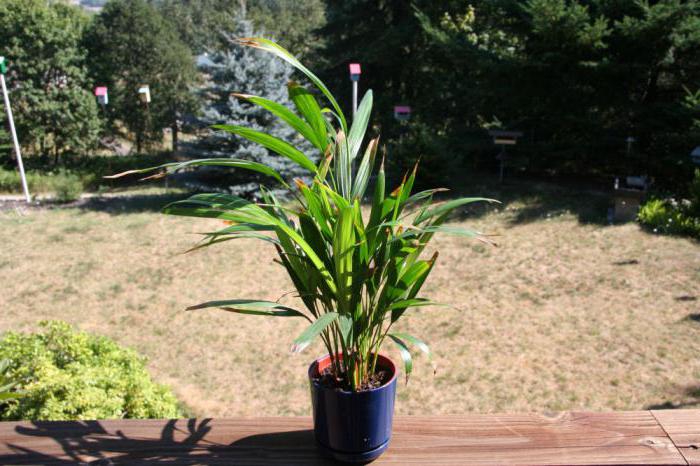

Since the betel tree belongs to tropical plants (its homeland is the Philippines, Madagascar, Indonesia and Fiji), it loves high temperatures - about +30 degrees. In a temperate climate, it is almost impossible to create such conditions all the time, except in summer. Therefore, it is important to protect the tree from low temperatures - to reduce the amount of ventilation in winter and to prevent the plant from being in a draft.
The palm tree loves high humidity, so it is recommended to periodically spray the leaves from a spray bottle. This advice is especially relevant in the summer.
How to become Myanmar in no time
Myanmar is gradually gaining popularity. Here you can see many interesting sights. But the most valuable and already quite rare thing that can be seen in this part of the world is the culture of this country that has remained unchanged to this day. The best way to get into it is to try to live like the locals yourself. To get a feel for this country and get, at least a tiny, experience of living in Myanmar according to its rules:
- Put on and wear lounges;
- Apply tanaka to face;
- Eat the food that the locals eat;
- For risky and completely reckless daredevils - try chewing betel nut.
We end the conversation with a few words against drugs. A person should know the truth about them, delightful and blissful ignorance is unacceptable here.When traveling to different countries, remember the dangers and dangers of using ANY kind of drugs, including betel nut! We are in the ranks of people who are against drug addiction and drugs! Be healthy and enjoy life naturally, without any stimulants!
Growth features
A young betel nut often has a fruit at its base that gave it life. In no case should it be forcibly removed - the tree will die. When it completely darkens and falls off, only then can it be removed.
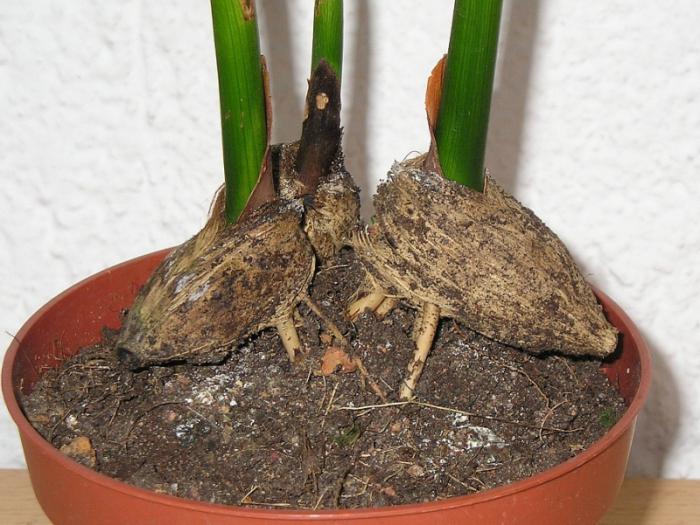

In stores, the plant is often sold as a bush, several pieces in one pot. Separating them during transplanting is not worth it: even the slightest damage to the roots ruins the entire "grove". It is better to buy a larger container and leave the trees together - this way they look even prettier.
Correct soil
All plants require soil with certain parameters. The betel tree is no exception. Growing it will be successful if you provide the tree with the most suitable soil. First of all, its reaction must be neutral or slightly acidic, and the earth is supposed to pass water and air well, and even be nutritious. Therefore, experienced plant breeders advise mixing universal soil for palm trees with pine bark, bone meal, charcoal, peat, pumice and large pebbles. If you are not lazy for your pets to prepare the soil yourself, combine leaf and turf soil, sand and black peat (2: 4: 1: 1).
Possible difficulties
| The problem (what happens to the leaves) | Cause | Prevention and treatment |
| Spots and curls. | Not enough potassium. | Consider the likelihood of such a situation when choosing a top dressing. |
| They are getting lighter. Plant growth slows down. | Not enough nitrogen. | |
| Begin to turn yellow. | Lack of moisture. | Water carefully, do not overdo it, but also do not run. Wait for the top of the substrate to dry. |
| Dry, light spots appear. | Excess light. | Shade, especially if the plant is young. Older palms should also be protected from excess light at noon. |
| Wither and darken. | The temperature is insufficient. | The room must be warm. |
| Ends dry. | Little moisture. | Spray the plant, especially when it is hot and dry. |
| Darken and fall. | Aging. | It is impossible to save a palm tree; it must be removed from other indoor plants. |
| Wither, red-brown spots are formed. | Excess moisture. | Treat with any fungicide, strictly following the instructions. Stop watering. |
Main types
Florists grow several types of Dipsis Areca:
- Chrysalidocarpus madagascar;


- Areca three-stalked;
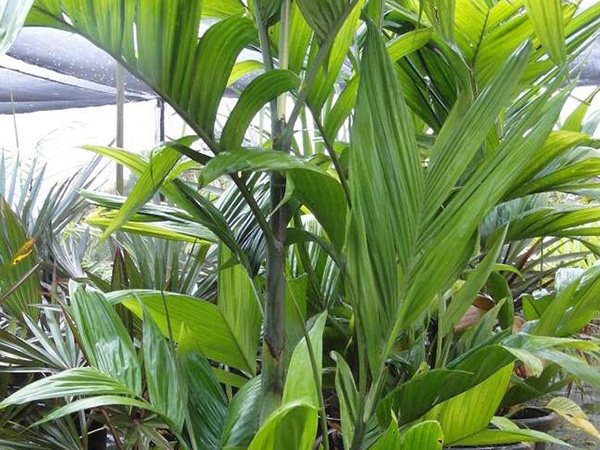

- Areca catechu (another name is Bethel palm);
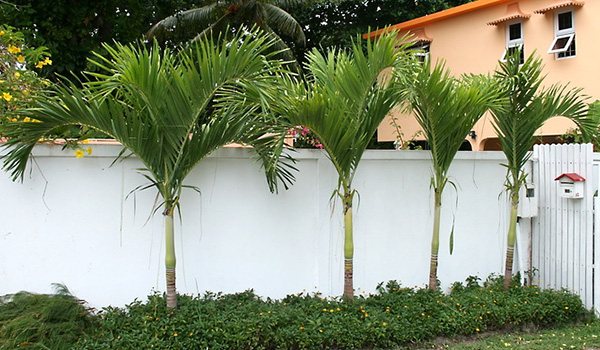

- Chrysalidocarpus yellowish.


Chrysalidocarpus Madagascar grows well in the winter garden or a greenhouse. It is highly decorative, the leaves are pinnate with a glossy finish, and the flowers have a golden hue.
In room culture, Chrysalidocarpus lutescens (yellowish) is widespread; this type is best suited for home conditions.
It has a decorative crown in the form of an arch and branched inflorescences on which are located small yellow flowers. The leaves of an adult Chrysalidocarpus are more than 1 meter, the length of the leaf segments is about 30 cm, and their width is 3 cm.
Attention! In the office or in the apartment, it is very rare to see the Dipsis bloom. But if the plant likes the conditions of detention, then it will delight with small yellow flowers located on panicles. Remember that fruits and flowers are poisonous.
Why is harmful betel nut so popular?
A dangerous but so popular betel nut ... It was chewed by kings and peasants, artisans and monks, men and women, young and old. Why is this bad habit still alive? Even fashionable and modern Yangon is full of people with fiery smiles, what can we say about the villages ... People chew betel nut, regardless of whether they are driving a bus, trade in the market, whether they operate a boat on the Ayeyarwady ... Almost the entire male population of the country chews and no less than half female ...
There are many reasons for its popularity. To begin with, it's cheap and affordable.
Secondly, it gave vigor and energy charge. His chewing discouraged hunger. He gave a feeling of mild euphoria.It is very likely that, along with deep religiosity, betel nut contributed to the wonderful Buddhist calm and confidence in a better future for the locals.
Thirdly, the person chewing it corresponded to the aesthetic ideas of the Burmese.
And finally, the centuries-old use of betel nut has developed certain norms of etiquette. Well-mannered ladies, among other things, should have been able to gracefully prepare such a bundle. To this day, a sign of cordial hospitality is the offer of betel nut. Even in the royal palace, he was the centerpiece. With his help, favor and discontent were expressed, many subtleties and nuances of etiquette were associated with him, there was a whole set of rules.
For such a significant and serious ritual of use, special accessories were required. And a large set of utensils was created for his use of betel nut. Lime boxes, special betel nut splitters, mortars, spoons, spittoons, trays and so on were made both as simple functional items and as exceptional works of art. Then the craftsmen used gold, silver, copper, and bronze for their work. The items were decorated with rich traditional ornaments and mythological designs. The picture shows several of these items from the British Museum, received as diplomatic gifts.


Burmese from generation to generation were convinced that chewing betel nut was very useful, as an anthelmintic and antiseptic, that it was a good pain reliever, that it was extremely useful for the stomach after a hearty meal, many beneficial properties were attributed to it. For a long time, science had to figure out what was true and what was not, many properties turned out to be imaginary. But it is difficult to quickly change human age-old prejudices.
Currently, more and more educated people in Burma are moving away from this habit. Civil servants and employees of respectable offices during working hours cannot chew betel nut. But there are people in the country with the opposite point of view, who believe that this is such a component of the true Myanmar culture, which must be preserved. Well, perhaps, you need to wean people to spit, anywhere. They are already trying to install such prohibition signs, but few people pay attention to them.
What does chrysalidocarpus areca look like?
The decorative palm tree grows naturally in the Comoros and Madagascar. The name "chrysalidocarpus" is translated as a golden fruit. There are 20 species in nature, but only areca is suitable for a home. In the description of chrysalidocarpus, it is indicated that the palm can be either single-stemmed or multi-stemmed. Non-branching bushes with smooth shoots can grow up to 10 m in height. The plant stands out for its numerous carved feathery and paired leaves, the number of which on the stem varies from 40 to 60.
Chrysalidocarpus dries: why and what to do?
Chrysalidocarpus dry leaves what to do
Butterfly palm is a chic decorative flowerpot that does not require special care in good light and humidity. But difficulties cannot be avoided.
Chrysalidocarpus leaves tips dry
Drying leaves, tips, edges are the most common problems. The first reason is a lack of moisture (dry air and substrate). As well as low temperature and mechanical damage. With such problems, you need to increase the number of sprays of the plant, remove it from the battery, install a container of water nearby.
Chrysalidocarpus leaves turn yellow and die off
The tips of the leaves can not only turn yellow, but also turn brown, and then die off. The reason may be an overabundance of feeding, which contains fluorine, superphosphates.
The leaves become covered with brown spots if a full bouquet of unfavorable conditions is collected: a sharp temperature drop, water for irrigation is too hard or taken from the tap. If the leaves have completely darkened, this is a signal of decay. Watering needs to be stopped urgently.
Yellow-brown spots will tell you about the plant getting sunburn. The palm tree urgently needs to be transferred to partial shade. The second sign of excess lighting is the wrapping of the leaf, the appearance of straw spots on it.
Reproduction methods
For areca, 2 methods of reproduction are applicable: by seeds and by dividing the bush. Let's consider them in more detail.
Seeds
Areca seeds can be sown in spring and summer... According to the technology, the seeds must be lowered for 10 minutes. in a solution of sulfuric acid and only then planted in the soil. The soil for sowing seeds should consist of equal parts of sand and peat. Immediately before laying the seeds, the soil is moistened, the seeds themselves are deepened into it by 2 cm.
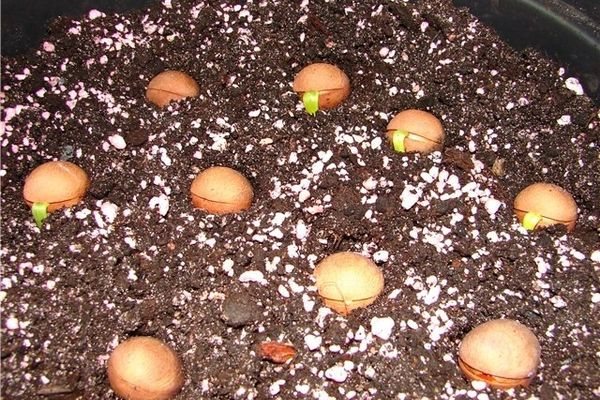

At a temperature of 27 ... 30 ° С the first shoots appear at 4-8 weeks... If this temperature cannot be kept and it drops slightly, seedlings should be expected in 3-4 months.
Basal processes
Reproduction by basal shoots is possible only when the plant has reached a decent age and gave new shoots. If your pet has pleased you with young shoots, it's time to start dividing. Prepare a separate pot for them, fill it with loose soil (2 parts of sod land, 1 part each of sand and humus).
Cut off the shoot carefully, moisten the potting soil and plant a sprout in it, not deepening the roots too much. Place in a warm place without direct sunlight. Water regularly and the young plant will take root in 2–3 weeks. After rooting, it is necessary to make the first feeding of the palm, taking half the dose of fertilizer.
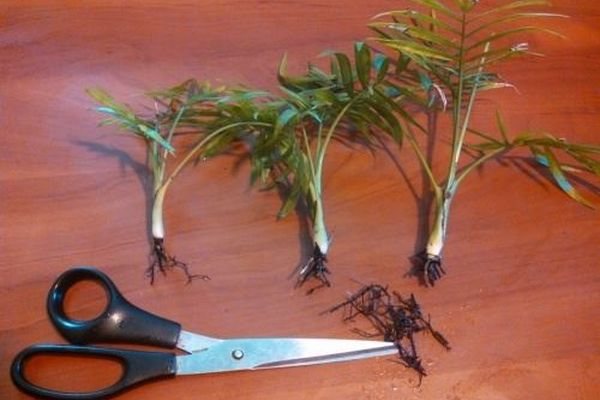

HABIT TO CHEW BETEL
Actually that little bundle that the Burmese chew consists of: a betel leaf, slaked lime obtained from the shells of molluscs or from limestone, which is smeared on this leaf, a betel nut is poured on top, which is crushed or thinly cut into slices), plus, if desired , all kinds of spice additives (cloves, cardamom, anise, cumin, cinnamon, nutmeg, black pepper, coriander, dry ginger), or tobacco, or sweetened grated coconut to add a fragrant smell or make it more harmful. You can buy betel nut in Myanmar at every corner and in every market.
In tiny street tents, where along with cigars, matches, sweets, next to the vendor, there is a pile of bright green betel leaves, a bowl with chopped betel nuts, a jar of lime, and several containers of spices. The buyer makes a choice and the seller gets to work. He puts a little slaked lime on a sheet, puts pieces or rounds of nut in the middle, places the spices, then carefully folds the sheet into a beautiful rectangle and places 4-5 of these pieces in a small plastic bag. Everything is done dexterously, with a certain grace.
Neatly packed in a piece of paper, this kind of gum is placed in the mouth behind the cheek and a slow chewing process begins. And here's the result. Outwardly - a blood-red smile of a ghoul with profuse and colored salivation, Internally - chemicals obtained as a result of chewing, quickly entering the bloodstream and causing numbness of the mouth and narcotic fogging of the brain. At the same time, it is impossible to swallow bright saliva, it has a strong irritating property, which is very harmful both for the stomach, and can easily cause intestinal upset, and even poisoning. The emerging betel nut habit is no less strong than the smoking habit
Areca palm diseases and effective treatment
These exotic plants fall ill mainly with rots of the root system, developing against the background of waterlogging of the soil.These ailments are accompanied by the following symptoms:
- wilting of the aerial parts of the palm;
- the appearance of reddish-brown spots on the leaf blades;
- the size of the spots increases, they begin to merge into continuous affected areas.
You can cure a pet if you start to act at the first signs of an illness. To do this, it is necessary to treat the palm leaves with a fungicidal agent, for example, Discor. The procedure is repeated after a week and a half.
It is also recommended to dry the soil: you can sprinkle the top layer with sand, and when it gets wet, change it to a new one. The pot is placed on newspapers, folded in several layers, as they are saturated with moisture, a new paper "bedding" is made.
With a strong overflow, it is worth replanting the palm tree, having previously dried the earthen lump in the open air. And after all the activities, it is important to adjust the irrigation regime.
It is important! During the treatment of rot in the areca, spraying the foliage and wiping them with a damp cloth is excluded.
Viruses and bacteria infect the areca palm extremely rarely, and when kept at home, the risks of a plant getting sick are significantly reduced. More often, negative signs are the consequences of a violation of the maintenance or care of an exotic flower:
- yellowing of foliage is a sign of moisture deficiency;
- the appearance of clarified dry spots on the plates - exposure to the crown of a palm tree of excessively aggressive sunlight;
- darkening and wilting of foliage - appear if the areca is kept in the cold;
- drying of the tips of the leaves - exposure to too dry air.
Sometimes changes in the appearance of a plant are associated with natural processes. For example, if in an adult palm the lower leaves acquire a brown hue and fall off, then the matter is in their aging and dying off, which is physiologically quite normal.
Shine
Bethel palm is a tropical tree that needs abundant lighting. It also tolerates the direct rays of the sun well, so it only needs shading on hot afternoons (from mid-May to late July). However, an abundance of light is not a prerequisite - the betel tree feels great in partial shade. So the choice of windows for its placement is the widest. The only thing that must be paid attention to: if the areca has been in a low-light place for a long time, it must be moved gradually under the bright sun to avoid burns. And so that the crown develops proportionally, weekly the pot turns its other side to the light source.


Diseases and pests
Areca palm can be damaged by pests such as scale insects, mealybugs, whiteflies and spider mites. At the first sign of the appearance of these parasites, the plant must be immediately and thoroughly treated with appropriate chemicals.
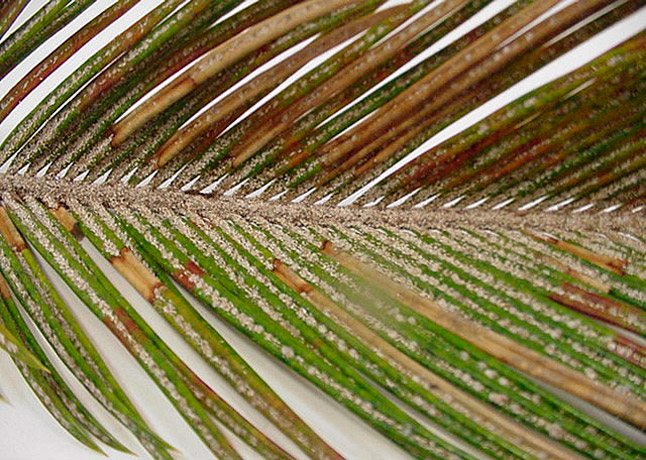

The most common disease is root decay. This is caused by abundant watering. Dry leaf tips are the result of improper care: dry air, cold, poor watering. If there is a lack of light, the leaves become pale, lethargic and the palm tree stops growing.
With proper care, the areca palm will be a great addition not only to your home, but also to your office.
3. Varieties:
3.1 Areca catechu or betel nut - Areca catechu
The betel palm or areca catechu is a beautiful medium-sized palm tree, up to 20 m high, with a slender ringed trunk 10 - 15 cm in diameter, a crown with a diameter of 1.5 - 4 m. It consists of numerous rounded feathery leaves. Petioles are wide, hard. The inflorescences are branched, bearing many male and female flowers. Male flowers are small and numerous; female flowers are single or in small groups of two or three flowers, much more than male flowers. All flowers are fragrant, whitish-yellow. Yields ovoid, dark yellow with a red tint, smooth fruits 5 - 8 cm long.
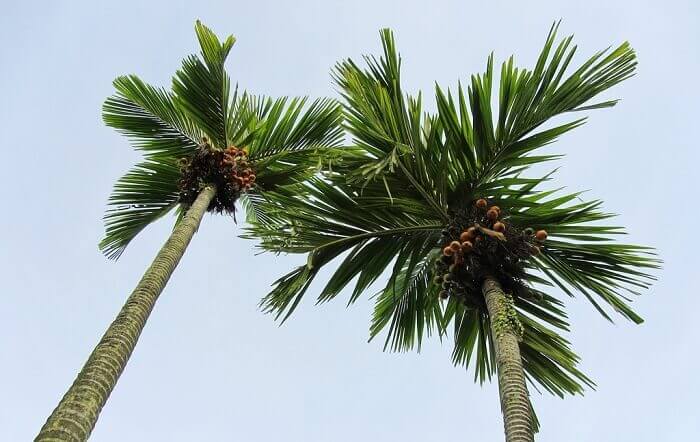

Pruning Areca
It is strictly forbidden to prune palm trees from the genus Arecs. Pruning the leaves can cause the plants to simply die.Even wilting, too affected leaves need to be shortened only to healthy tissues, leaving a thin rim of dry areas in front of them. Cutting off whole leaves due to the deep location of the vagina can lead to disastrous consequences, not to mention the spread of diseases.
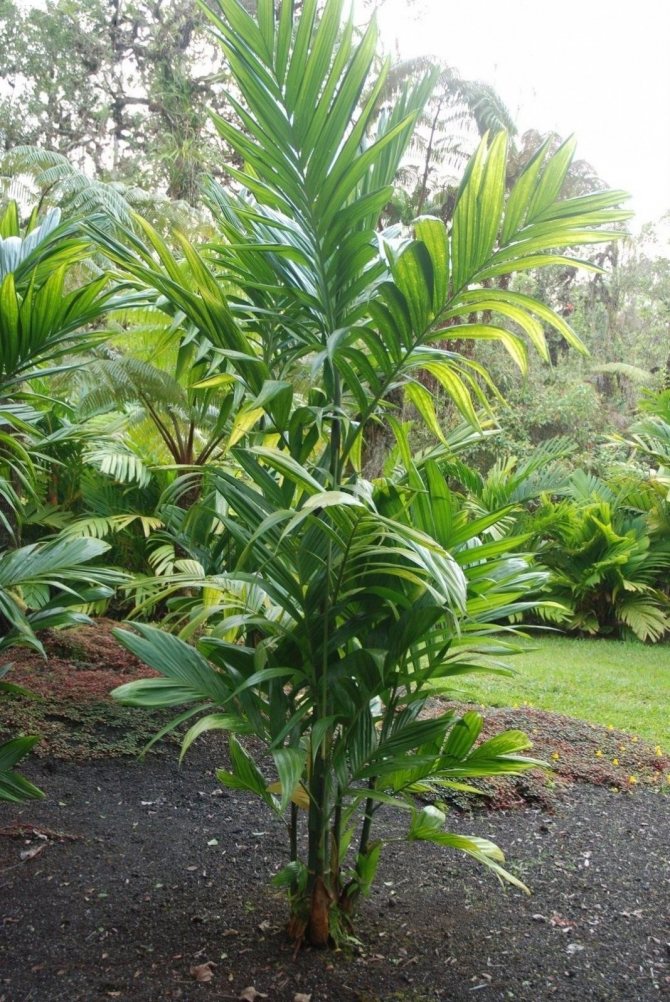

Areca three-stalked (Areca triandra). <>


